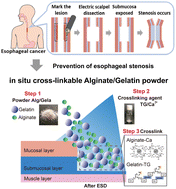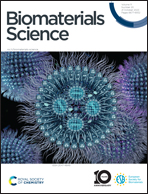Prevention of esophageal stenosis via in situ cross-linkable alginate/gelatin powder in a new submucosal exfoliation model in rats†
Abstract
Endoscopic submucosal dissection (ESD) for the treatment of esophageal mucosal lesions often leads to postoperative stenosis, causing difficulty in swallowing, known as dysphagia. In this study, we developed an in situ cross-linkable powder composed of alginate, gelatin, transglutaminase (TG), and calcium chloride ions (Ca2+), which can be administered through a 1.5 m-long and 3.2 mm-diameter endoscopic instrument channel. The powdered mixture of alginate and gelatin quickly formed a hydrogel by absorbing body fluids and was cross-linked by TG and Ca2+, which adhered ex vivo to porcine submucosal layers for over 2 weeks. In addition, we developed a new submucosal exfoliation model in rats that induced severe stenosis, similar to the ESD-induced stenosis models in clinical practice. When administered to the new rat model, the powder system effectively reduced the severity of esophageal stenosis based on body weight change monitoring, anatomical findings, and histological analysis. The body weight of the rats was maintained at the initial weight on postoperative day 14 (POD14), and epithelialization on POD7 and 14 improved to almost 100%. Additionally, collagen accumulation and the number of α-SMA-positive cells decreased due to powder administration. Therefore, these findings indicate that the in situ cross-linkable powder can prevent esophageal stenosis after ESD.



 Please wait while we load your content...
Please wait while we load your content...